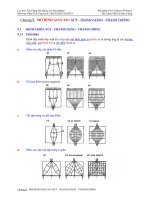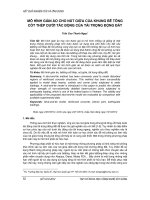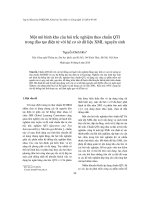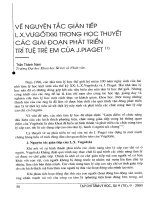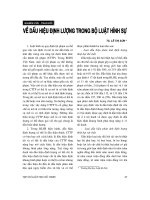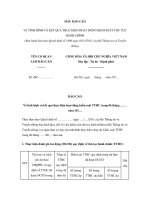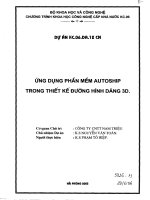Báo cáo về mô hình giàn ảo trong thiết kế cầu (Đại học Texas)
Bạn đang xem bản rút gọn của tài liệu. Xem và tải ngay bản đầy đủ của tài liệu tại đây (11.01 MB, 276 trang )
1. Report No.
FHWA/TX-12/5-5253-01-1
Technical Report Documentation Page
2. Government
3. Recipient’s Catalog No.
Accession No.
4. Title and Subtitle
5. Report Date
Strut-and-Tie Model Design Examples for Bridges:Final Report
October 2011, Rev. 2012: Pub. June 2012
7. Author(s)
Chris Williams, Dean Deschenes, and Oguzhan Bayrak
6. Performing Organization Code
8. Performing Organization Report No.
5-5253-01-1
9. Performing Organization Name and Address
Center for Transportation Research
The University of Texas at Austin
1616 Guadalupe Street, Suite 4.202
Austin, TX 78701
10. Work Unit No. (TRAIS)
11. Contract or Grant No.
5-5253-01
12. Sponsoring Agency Name and Address
Texas Department of Transportation
Research and Technology Implementation Office
P.O. Box 5080
Austin, TX 78763-5080
13. Type of Report and Period Covered
Technical Report 9/1/2009 – 8/31/2011
14. Sponsoring Agency Code
15. Supplementary Notes
Project performed in cooperation with the Texas Department of Transportation and the Federal Highway
Administration.
16. Abstract
A series of five detailed design examples feature the application of state-of-the-art strut-and-tie modeling
(STM) design recommendations. This guidebook is intended to serve as a designer’s primary reference
material in the application of STM to bridge components.
• Example 1: Five-Column Bent Cap of a Skewed Bridge – This design example serves as an
introduction to the application of strut-and-tie modeling. Challenges are introduced by the bridge’s
skew and complicated loading pattern. A clear procedure for defining nodal geometries is presented.
• Example 2: Cantilever Bent Cap – A strut-and-tie model is developed to represent the flow of forces
around a frame corner subjected to closing loads. This is accomplished, in part, through the design and
detailing of a curved-bar node at the outside of the frame corner.
• Example 3a: Inverted-T Straddle Bent Cap (Moment Frame) – An inverted-T straddle bent cap is
modeled as a component within a moment frame. Bottom-chord (ledge) loading of the inverted-T
necessitates the use of local STMs to model the flow of forces through the bent cap’s cross section.
• Example 3b: Inverted-T Straddle Bent Cap (Simply Supported) – The inverted-T bent cap of
Example 3a is designed as a simply supported member. Results for both the moment frame case and
the simply supported case are compared to illustrate the influence of boundary condition assumptions.
• Example 4: Drilled-Shaft Footing – Three-dimensional STMs are developed to properly model the
flow of forces through a deep drilled-shaft footing. Two unique load cases are considered to
familiarize the designer with the development of such models.
17. Key Words
Strut-and-Tie Modeling, Strength, Serviceability,
Bent Cap, Cantilever, Inverted-T, Drilled-Shaft
Footing
18. Distribution Statement
No restrictions. This document is available to the
public through the National Technical Information
Service, Springfield, Virginia 22161; www.ntis.gov.
19. Security Classif. (of report) 20. Security Classif. (of this page) 21. No. of pages
Unclassified
Unclassified
276
Form DOT F 1700.7 (8-72) Reproduction of completed page authorized
22. Price
Strut-and-Tie Model Design Examples for Bridges: Final Report
Chris Williams
Dean Deschenes
Oguzhan Bayrak
CTR Technical Report:
Report Date:
Project:
Project Title:
Sponsoring Agency:
Performing Agency:
5-5253-01-1
October 2011, Rev. June 2012
5-5253-01
Strut-and-Tie Model Design Examples for Bridges
Texas Department of Transportation
Center for Transportation Research at The University of Texas at Austin
Project performed in cooperation with the Texas Department of Transportation and the Federal Highway
Administration.
Center for Transportation Research
The University of Texas at Austin
1616 Guadalupe, Suite 4.202
Austin, TX 78701
www.utexas.edu/research/ctr
Copyright (c) 2012
Center for Transportation Research
The University of Texas at Austin
All rights reserved
Printed in the United States of America
iv
Disclaimers
Author's Disclaimer: The contents of this report reflect the views of the authors, who
are responsible for the facts and the accuracy of the data presented herein. The contents do not
necessarily reflect the official view or policies of the Federal Highway Administration or the
Texas Department of Transportation (TxDOT). This report does not constitute a standard,
specification, or regulation.
Patent Disclaimer: There was no invention or discovery conceived or first actually
reduced to practice in the course of or under this contract, including any art, method, process,
machine manufacture, design or composition of matter, or any new useful improvement thereof,
or any variety of plant, which is or may be patentable under the patent laws of the United States
of America or any foreign country.
Engineering Disclaimer
NOT INTENDED FOR CONSTRUCTION, BIDDING, OR PERMIT PURPOSES.
Project Engineer: Oguzhan Bayrak
Professional Engineer License State and Number: Texas No. 106598
P. E. Designation: Research Supervisor
v
Acknowledgments
The authors express sincere gratitude to the Texas Department of Transportation
(TxDOT) for their support of this implementation project. The guidance and technical
contributions of Dean Van Landuyt (Bridge Division) and John Vogel (Houston District) greatly
improved the quality of this report, and their efforts are deeply appreciated.
vi
Table of Contents
Chapter 1. Introduction................................................................................................................ 1
1.1 Background ........................................................................................................................... 1
1.2 Project Objective and Scope ................................................................................................. 2
1.3 Organization.......................................................................................................................... 2
Chapter 2. Introduction to Strut-and-Tie Modeling ................................................................. 5
2.1 Overview ............................................................................................................................... 5
2.2 Discontinuity Regions of Beams .......................................................................................... 5
2.3 Overview of Strut-and-Tie Modeling ................................................................................... 7
2.3.1 Fundamentals of Strut-and-Tie Modeling ...................................................................... 7
2.3.2 Prismatic and Bottle-Shaped Struts ............................................................................... 8
2.3.3 Strut-and-Tie Model Design Procedure ......................................................................... 9
2.4 Separate B- and D-Regions................................................................................................. 11
2.5 Define Load Case................................................................................................................ 11
2.6 Analyze Structural Component ........................................................................................... 12
2.7 Size Component Using the Shear Serviceability Check ..................................................... 12
2.8 Develop Strut-and-Tie Model ............................................................................................. 14
2.8.1 Overview of Strut-and-Tie Model Development ......................................................... 14
2.8.2 Determine Geometry of Strut-and-Tie Model ............................................................. 15
2.8.3 Create Efficient and Realistic Strut-and-Tie Models – Rules of Thumb ..................... 16
2.8.4 Analyze Strut-and-Tie Model ...................................................................................... 18
2.9 Proportion Ties ................................................................................................................... 21
2.10 Perform Nodal Strength Checks ....................................................................................... 21
2.10.1 Hydrostatic Nodes versus Non-Hydrostatic Nodes ................................................... 21
2.10.2 Types of Nodes .......................................................................................................... 22
2.10.3 Proportioning CCT Nodes ......................................................................................... 22
2.10.4 Proportioning CCC Nodes ......................................................................................... 23
2.10.5 Proportioning CTT Nodes.......................................................................................... 27
2.10.6 Designing Curved-Bar Nodes .................................................................................... 28
2.10.7 Calculating Nodal Strengths ...................................................................................... 29
2.10.8 Special Consideration – Back Face of CCT/CTT Nodes ........................................... 34
2.11 Proportion Crack Control Reinforcement ......................................................................... 35
2.12 Provide Necessary Anchorage for Ties ............................................................................ 37
2.13 Summary ........................................................................................................................... 38
Chapter 3. Proposed Strut-and-Tie Modeling Specifications ................................................. 39
3.1 Introduction ......................................................................................................................... 39
3.2 Overview of TxDOT Project 0-5253 .................................................................................. 39
3.2.1 Deep Beam Database ................................................................................................... 39
3.2.2 Experimental Program ................................................................................................. 40
3.2.3 Objectives and Corresponding Conclusions ................................................................ 41
3.3 Proposed Strut-and-Tie Modeling Specifications ............................................................... 44
3.3.1 Overview of Proposed Specifications .......................................................................... 44
3.3.2 Updates to the TxDOT Project 0-5253 Specifications ................................................ 44
3.3.3 Proposed Revisions to the AASHTO LRFD Bridge Design Specifications................ 46
vii
3.4 Summary ............................................................................................................................. 58
Chapter 4. Example 1: Five-Column Bent Cap of a Skewed Bridge ..................................... 59
4.1 Synopsis .............................................................................................................................. 59
4.2 Design Task ........................................................................................................................ 59
4.2.1 Bent Cap Geometry...................................................................................................... 59
4.2.2 Determine the Loads .................................................................................................... 63
4.2.3 Determine the Bearing Areas ....................................................................................... 66
4.2.4 Material Properties ....................................................................................................... 69
4.3 Design Procedure ................................................................................................................ 69
4.4 Design Calculations ............................................................................................................ 70
4.4.1 Step 1: Analyze Structural Component........................................................................ 70
4.4.2 Step 2: Develop Strut-and-Tie Model .......................................................................... 70
4.4.3 Step 3: Proportion Longitudinal Ties ........................................................................... 75
4.4.4 Step 4: Perform Nodal Strength Checks ...................................................................... 76
4.4.5 Step 5: Proportion Stirrups in High Shear Regions ..................................................... 91
4.4.6 Step 6: Proportion Crack Control Reinforcement ........................................................ 96
4.4.7 Step 7: Provide Necessary Anchorage for Ties ........................................................... 96
4.4.8 Step 8: Perform Shear Serviceability Check ................................................................ 98
4.5 Reinforcement Layout ...................................................................................................... 101
4.6 Comparison of STM Design to Sectional Design ............................................................. 104
4.7 Summary ........................................................................................................................... 105
Chapter 5. Example 2: Cantilever Bent Cap .......................................................................... 107
5.1 Synopsis ............................................................................................................................ 107
5.2 Design Task ...................................................................................................................... 107
5.2.1 Bent Cap Geometry.................................................................................................... 107
5.2.2 Determine the Loads .................................................................................................. 109
5.2.3 Determine the Bearing Areas ..................................................................................... 111
5.2.4 Material Properties ..................................................................................................... 113
5.3 Design Procedure .............................................................................................................. 113
5.4 Design Calculations .......................................................................................................... 114
5.4.1 Step 1: Analyze Structural Component...................................................................... 114
5.4.2 Step 2: Develop Strut-and-Tie Models ...................................................................... 115
5.4.3 Step 3: Proportion Vertical Tie and Crack Control Reinforcement ........................... 120
5.4.4 Step 4: Proportion Longitudinal Ties ......................................................................... 122
5.4.5 Step 5: Perform Nodal Strength Checks .................................................................... 123
5.4.6 Step 6: Provide Necessary Anchorage for Ties ......................................................... 132
5.4.7 Step 7: Perform Shear Serviceability Check .............................................................. 134
5.5 Reinforcement Layout ...................................................................................................... 134
5.6 Summary ........................................................................................................................... 136
Chapter 6. Example 3a: Inverted-T Straddle Bent Cap (Moment Frame) ......................... 137
6.1 Synopsis ............................................................................................................................ 137
6.2 Design Task ...................................................................................................................... 137
6.2.1 Bent Cap Geometry.................................................................................................... 137
6.2.2 Determine the Loads .................................................................................................. 139
6.2.3 Determine the Bearing Areas ..................................................................................... 141
viii
6.2.4 Material Properties ..................................................................................................... 141
6.2.5 Inverted-T Terminology............................................................................................. 141
6.3 Design Procedure .............................................................................................................. 141
6.4 Design Calculations .......................................................................................................... 143
6.4.1 Step 1: Analyze Structural Component and Develop Global STM ........................... 143
6.4.2 Step 2: Develop Local Strut-and-Tie Models ............................................................ 148
6.4.3 Step 3: Proportion Longitudinal Ties ......................................................................... 151
6.4.4 Step 4: Proportion Hanger Reinforcement/Vertical Ties ........................................... 152
6.4.5 Step 5: Proportion Ledge Reinforcement .................................................................. 155
6.4.6 Step 6: Perform Nodal Strength Checks .................................................................... 157
6.4.7 Step 7: Proportion Crack Control Reinforcement ...................................................... 172
6.4.8 Step 8: Provide Necessary Anchorage for Ties ......................................................... 173
6.4.9 Step 9: Perform Other Necessary Checks .................................................................. 175
6.4.10 Step 10: Perform Shear Serviceability Check .......................................................... 175
6.5 Reinforcement Layout ...................................................................................................... 176
6.6 Summary ........................................................................................................................... 179
Chapter 7. Example 3b: Inverted-T Straddle Bent Cap (Simply Supported)..................... 181
7.1 Synopsis ............................................................................................................................ 181
7.2 Design Task ...................................................................................................................... 181
7.2.1 Bent Cap Geometry.................................................................................................... 181
7.2.2 Determine the Loads .................................................................................................. 183
7.2.3 Determine the Bearing Areas ..................................................................................... 185
7.2.4 Material Properties ..................................................................................................... 185
7.3 Design Procedure .............................................................................................................. 185
7.4 Design Calculations .......................................................................................................... 185
7.4.1 Step 1: Develop Global Strut-and-Tie Model ............................................................ 185
7.4.2 Step 2: Develop Local Strut-and-Tie Models ............................................................ 188
7.4.3 Step 3: Proportion Longitudinal Ties ......................................................................... 191
7.4.4 Step 4: Proportion Hanger Reinforcement/Vertical Ties ........................................... 191
7.4.5 Step 5: Proportion Ledge Reinforcement .................................................................. 193
7.4.6 Step 6: Perform Nodal Strength Checks .................................................................... 194
7.4.7 Step 7: Proportion Crack Control Reinforcement ...................................................... 201
7.4.8 Step 8: Provide Necessary Anchorage for Ties ......................................................... 201
7.4.9 Step 9: Perform Other Necessary Checks .................................................................. 203
7.4.10 Step 10: Perform Shear Serviceability Check .......................................................... 203
7.5 Reinforcement Layout ...................................................................................................... 204
7.6 Comparison of Two STM Designs – Moment Frame and Simply Supported.................. 207
7.7 Serviceability Behavior of Existing Field Structure ......................................................... 208
7.8 Summary ........................................................................................................................... 209
Chapter 8. Example 4: Drilled-Shaft Footing ........................................................................ 211
8.1 Synopsis ............................................................................................................................ 211
8.2 Design Task ...................................................................................................................... 211
8.2.1 Drilled-Shaft Footing Geometry ................................................................................ 211
8.2.2 First Load Case .......................................................................................................... 213
8.2.3 Second Load Case ...................................................................................................... 213
8.2.4 Material Properties ..................................................................................................... 214
ix
8.3 Design Procedure .............................................................................................................. 214
8.4 Design Calculations (First Load Case) ............................................................................. 214
8.4.1 Step 1: Determine the Loads ...................................................................................... 214
8.4.2 Step 2: Analyze Structural Component...................................................................... 218
8.4.3 Step 3: Develop Strut-and-Tie Model ........................................................................ 218
8.4.4 Step 4: Proportion Ties .............................................................................................. 224
8.4.5 Step 5: Perform Strength Checks ............................................................................... 226
8.4.6 Step 6: Proportion Shrinkage and Temperature Reinforcement ................................ 229
8.4.7 Step 7: Provide Necessary Anchorage for Ties ......................................................... 230
8.5 Design Calculations (Second Load Case) ......................................................................... 232
8.5.1 Step 1: Determine the Loads ...................................................................................... 232
8.5.2 Step 2: Analyze Structural Component...................................................................... 235
8.5.3 Step 3: Develop Strut-and-Tie Model ........................................................................ 235
8.5.4 Step 4: Proportion Ties .............................................................................................. 238
8.5.5 Step 5: Perform Strength Checks ............................................................................... 240
8.5.6 Step 6: Proportion Shrinkage and Temperature Reinforcement ................................ 240
8.5.7 Step 7: Provide Necessary Anchorage for Ties ......................................................... 241
8.6 Reinforcement Layout ...................................................................................................... 243
8.7 Summary ........................................................................................................................... 249
Chapter 9. Summary and Concluding Remarks .................................................................... 251
9.1 Summary ........................................................................................................................... 251
9.2 Concluding Remarks......................................................................................................... 252
References .................................................................................................................................. 255
x
List of Figures
Figure 1.1: Strut-and-tie model for a beam ..................................................................................... 1
Figure 2.1: Stress trajectories within B- and D-regions of a flexural member (adapted
from Birrcher et al., 2009) .................................................................................................. 5
Figure 2.2: (a) One-panel (arch action); (b) two-panel (truss action) strut-and-tie models
for deep beam region (adapted from Birrcher et al., 2009) ................................................ 6
Figure 2.3: Struts, ties, and nodes within a strut-and-tie model ..................................................... 7
Figure 2.4: Prismatic and bottle-shape struts within a strut-and-tie model (adapted from
Birrcher et al., 2009) ........................................................................................................... 8
Figure 2.5: Strut-and-tie model design procedure ........................................................................ 10
Figure 2.6: Linear stress distribution assumed at the interface of a B-region and a Dregion ................................................................................................................................ 12
Figure 2.7: Diagonal cracking load equation with experimental data (from Birrcher et al.,
2009) ................................................................................................................................. 14
Figure 2.8: Placement of the longitudinal ties and prismatic struts within a strut-and-tie
model................................................................................................................................. 15
Figure 2.9: Elastic stress distribution and corresponding strut-and-tie model for cantilever
bent cap of Chapter 5 ........................................................................................................ 16
Figure 2.10: Choosing optimal strut-and-tie model based on number and lengths of ties
(adapted from MacGregor and Wight, 2005) ................................................................... 17
Figure 2.11: Using the least number of vertical ties (and truss panels) as possible ..................... 18
Figure 2.12: Steps for the development of a strut-and-tie model ................................................. 20
Figure 2.13: Nodal proportioning techniques - hydrostatic versus non-hydrostatic nodes
(adapted from Birrcher et al., 2009).................................................................................. 22
Figure 2.14: Three types of nodes within a strut-and-tie model (adapted from Birrcher et
al., 2009) ........................................................................................................................... 22
Figure 2.15: Geometry of a CCT node (adapted from Birrcher et al., 2009) ............................... 23
Figure 2.16: CCC node – (a) original geometry of the STM; (b) adjacent struts resolved
together; (c) node divided into two parts; (d) final nodal geometry ................................. 24
Figure 2.17: Geometry of a CCC node (adapted from Birrcher et al., 2009) ............................... 25
Figure 2.18: Optimizing the height of the strut-and-tie model (i.e., the moment arm, jd) ........... 26
Figure 2.19: Determination of available length of vertical tie connecting two smeared
nodes (adapted from Wight and Parra-Montesinos, 2003) ............................................... 28
Figure 2.20: Curved-bar node at the outside of a frame corner (adapted from Klein, 2008) ....... 29
Figure 2.21: Determination of A2 for stepped or sloped supports (from ACI 318-08) ................. 30
Figure 2.22: Concrete efficiency factors, ν (node illustrations).................................................... 32
Figure 2.23: Stresses within a bottle-shaped strut ........................................................................ 34
Figure 2.24: Stress condition at the back face of a CCT node – (a) bond stress resulting
from the anchorage of a developed tie; (b) bearing stress applied from an anchor
plate or headed bar; (c) interior node over a continuous support ..................................... 35
xi
Figure 2.25: Illustration of variables within Equations 2.11 and 2.12.......................................... 36
Figure 2.26: Available development length for ties (adapted from Birrcher et al., 2009)............ 37
Figure 3.1: Scaled comparison of deep beams (from Birrcher et al., 2009) ................................. 40
Figure 3.2: Elevation view of test setup for TxDOT Project 0-5253 (from Birrcher et al.,
2009) ................................................................................................................................. 41
Figure 4.1: Plan and elevation views of five-column bent cap (left) ............................................ 60
Figure 4.2: Plan and elevation views of five-column bent cap (right).......................................... 61
Figure 4.3: Transverse slab sections for forward and back spans................................................. 62
Figure 4.4: Factored loads acting on the bent cap (excluding self-weight) .................................. 64
Figure 4.5: Assumed location of girder loads ............................................................................... 65
Figure 4.6: Determining when to combine loads – (a) Combine loads together; (b) keep
loads independent.............................................................................................................. 66
Figure 4.7: Assumed square area for the columns ........................................................................ 67
Figure 4.8: Effective bearing area considering effect of bearing seat .......................................... 68
Figure 4.9: Assumed bearing areas for girder loads – (a) single girder load; (b) two girder
loads that have been combined ......................................................................................... 69
Figure 4.10: Strut-and-tie model for the five-column bent cap .................................................... 71
Figure 4.11: Determining the location of the top and bottom chords of the STM ....................... 72
Figure 4.12: Orientation of diagonal members – (a) incorrect; (b) correct .................................. 73
Figure 4.13: Minimizing number of truss panels – (a) efficient; (b) inefficient ........................... 74
Figure 4.14: Modeling flow of forces near Column 2 – (a) efficient/realistic;
(b) inefficient/unrealistic ................................................................................................... 74
Figure 4.15: Determination of triaxial confinement factor, m, at Column 4 ................................ 76
Figure 4.16: Node JJ – (a) from STM; (b) with resolved struts .................................................... 78
Figure 4.17: Node JJ subdivided into two parts ............................................................................ 79
Figure 4.18: Node JJ – right nodal subdivision ............................................................................ 80
Figure 4.19: Node JJ – left nodal subdivision............................................................................... 82
Figure 4.20: Adjusting the angle of Strut P/JJ due to the subdivision of Node JJ ........................ 83
Figure 4.21: Node P shown with Node JJ and Strut P/JJ .............................................................. 84
Figure 4.22: Node R ...................................................................................................................... 85
Figure 4.23: Node Q ..................................................................................................................... 86
Figure 4.24: Node EE – (a) from STM and (b) with resolved struts and subdivided into
three parts .......................................................................................................................... 88
Figure 4.25: Node EE ................................................................................................................... 88
Figure 4.26: Nodes V and NN and Strut V/NN ............................................................................ 90
Figure 4.27: Determination of the available length for Tie L/FF (adapted from Wight and
Parra-Montesinos, 2003) ................................................................................................... 92
Figure 4.28: Limiting the assumed available lengths for ties to prevent overlap ......................... 94
Figure 4.29: (a) Available length for Tie P/II; (b) required spacing for Tie P/II extended
to the column..................................................................................................................... 95
xii
Figure 4.30: Anchorage of bottom chord reinforcement at Node NN .......................................... 97
Figure 4.31: Anchorage of top chord reinforcement at Node V ................................................... 98
Figure 4.32: Diagonal cracking load equation with experimental data and the normalized
service shear for two regions of the bent cap (adapted from Birrcher et al., 2009) ........ 100
Figure 4.33: Reinforcement details – elevation (design per proposed STM specifications) ...... 102
Figure 4.34: Reinforcement details – cross-sections (design per proposed STM
specifications) ................................................................................................................. 103
Figure 4.35: Reinforcement details near Column 4 – (a) STM design; (b) sectional design ..... 104
Figure 5.1: Plan and elevation views of cantilever bent cap (simplified geometry)................... 108
Figure 5.2: Plan and elevation views of cantilever bent cap (detailed geometry) ...................... 108
Figure 5.3: Factored loads acting on the bent cap (excluding self-weight) – (a) from each
beam/girder; (b) resolved loads ...................................................................................... 110
Figure 5.4: Adding factored self-weight to the superstructure loads .......................................... 111
Figure 5.5: Effective bearing areas considering effect of bearing seats (elevation) ................... 112
Figure 5.6: Effective bearing areas considering effect of bearing seats (plan) ........................... 112
Figure 5.7: Linear stress distribution at the boundary of the D-region....................................... 115
Figure 5.8: Strut-and-tie model for the cantilever bent cap – Option 1 ...................................... 116
Figure 5.9: Strut-and-tie model for the cantilever bent cap – Option 2 ...................................... 117
Figure 5.10: Modeling compressive forces within the column – (a) single strut; (b) two
struts ................................................................................................................................ 118
Figure 5.11: Determining the vertical position of Node E.......................................................... 120
Figure 5.12: Node E .................................................................................................................... 124
Figure 5.13: Node B .................................................................................................................... 126
Figure 5.14: Node C .................................................................................................................... 128
Figure 5.15: Stresses acting at a curved bar (adapted from Klein, 2008) ................................... 131
Figure 5.16: Bend radius, rb, at Node A ..................................................................................... 132
Figure 5.17: Anchorage of longitudinal bars at Node C ............................................................. 133
Figure 5.18: Reinforcement details – elevation (design per proposed STM specifications) ...... 135
Figure 5.19: Reinforcement details – Section A-A (design per proposed STM
specifications) ................................................................................................................. 135
Figure 5.20: Reinforcement details – Section B-B (design per proposed STM
specifications) ................................................................................................................. 136
Figure 6.1: Plan and elevation views of inverted-T bent cap ..................................................... 138
Figure 6.2: Factored superstructure loads acting on the bent cap ............................................... 139
Figure 6.3: Factored loads acting on the global strut-and-tie model for the inverted-T bent
cap (moment frame case) ................................................................................................ 140
Figure 6.4: Defining hanger and ledge reinforcement ................................................................ 141
Figure 6.5: Bent divided into D-regions and B-regions.............................................................. 142
Figure 6.6: Global strut-and-tie model for the inverted-T bent cap (moment frame case) ......... 144
Figure 6.7: Analysis of moment frame – factored superstructure loads ..................................... 145
xiii
Figure 6.8: Analysis of moment frame – factored superstructure loads and tributary selfweight.............................................................................................................................. 147
Figure 6.9: Local strut-and-tie model at Beam Line 1 (moment frame case) ............................. 149
Figure 6.10: Comparing the local strut-and-tie models (moment frame case) ........................... 150
Figure 6.11: Available lengths for hanger reinforcement – plan and elevation views ............... 153
Figure 6.12: Available lengths for ledge reinforcement ............................................................. 156
Figure 6.13: Dimension af ........................................................................................................... 156
Figure 6.14: Top portion of ledge reinforcement carries force in Tie CsFs ................................ 157
Figure 6.15: Illustration of struts and nodes within the inverted-T bent cap .............................. 158
Figure 6.16: Node G (moment frame case) ................................................................................ 159
Figure 6.17: Determination of triaxial confinement factor, m, for Node G................................ 161
Figure 6.18: Node C (moment frame case) ................................................................................. 163
Figure 6.19: Node C – left nodal subdivision (moment frame case) .......................................... 164
Figure 6.20: Node C – right nodal subdivision (moment frame case) ........................................ 165
Figure 6.21: Node K (moment frame case) ................................................................................ 167
Figure 6.22: Bend radius, rb, at Node F (moment frame case) ................................................... 170
Figure 6.23: Node Cs of local STM at Beam Line 1 (moment frame case) ................................ 171
Figure 6.24: Anchorage of bottom chord reinforcement at Node G ........................................... 173
Figure 6.25: Anchorage of ledge reinforcement at Node Cs ....................................................... 174
Figure 6.26: Reinforcement details – elevation (design per proposed STM specifications
– moment frame case) ..................................................................................................... 177
Figure 6.27: Reinforcement details – cross-sections (design per proposed STM
specifications – moment frame case) .............................................................................. 178
Figure 7.1: Plan and elevation views of inverted-T bent cap ..................................................... 182
Figure 7.2: Factored superstructure loads acting on the bent cap ............................................... 183
Figure 7.3: Factored loads acting on the global strut-and-tie model for the inverted-T bent
cap (simply supported case) ............................................................................................ 184
Figure 7.4: Global strut-and-tie model for the inverted-T bent cap (simply supported
case) ................................................................................................................................ 186
Figure 7.5: Determining the location of the top chord of the global STM ................................. 187
Figure 7.6: Local strut-and-tie model at Beam Line 1 (simply supported case)......................... 189
Figure 7.7: Comparing the local strut-and-tie models (simply supported case) ......................... 190
Figure 7.8: Diagonal strut inclinations (greater than 25 degrees) ............................................... 191
Figure 7.9: Vertical tie widths .................................................................................................... 192
Figure 7.10: Node P (simply supported case) ............................................................................. 195
Figure 7.11: Node E – resolved struts (simply supported case) ................................................. 196
Figure 7.12: Node E – refined geometry (simply supported case) ............................................. 198
Figure 7.13: Node C (simply supported case) ............................................................................ 199
Figure 7.14: Anchorage of bottom chord reinforcement at Node H ........................................... 202
xiv
Figure 7.15: Reinforcement details – elevation (design per proposed STM specifications
– simply supported)......................................................................................................... 205
Figure 7.16: Reinforcement details – cross-sections (design per proposed STM
specifications – simply supported case) .......................................................................... 206
Figure 7.17: Existing field structure (inverted-T straddle bent cap) – (a) Upstation;
(b) Downstation .............................................................................................................. 209
Figure 8.1: Plan and elevation views of drilled-shaft footing ..................................................... 212
Figure 8.2: Factored load and moment of the first load case ...................................................... 213
Figure 8.3: Factored load and moment of the second load case ................................................. 213
Figure 8.4: Developing an equivalent force system from the applied force and moment .......... 215
Figure 8.5: Linear stress distribution over the column cross section and the locations of
the loads comprising the equivalent force system (first load case) ................................ 216
Figure 8.6: Assumed reinforcement layout of the column section ............................................. 217
Figure 8.7: Applied loading and drilled-shaft reactions (first load case) ................................... 218
Figure 8.8: Strut-and-tie model for the drilled-shaft footing – axonometric view (first load
case) ................................................................................................................................ 219
Figure 8.9: Strut-and-tie model for the drilled-shaft footing – plan view (first load case)......... 220
Figure 8.10: Determining the location of the bottom horizontal ties of the STM ...................... 221
Figure 8.11: Potential positions of Nodes A and D (and Strut AD) ........................................... 221
Figure 8.12: Alternative strut-and-tie model for the first load case ............................................ 224
Figure 8.13: Spacing of bottom mat reinforcement .................................................................... 225
Figure 8.14: Anchorage of bottom mat reinforcement ............................................................... 231
Figure 8.15: Anchorage of vertical ties – unknown available length ......................................... 232
Figure 8.16: Factored load and moment of the second load case ............................................... 233
Figure 8.17: Linear stress distribution over the column cross section and the locations of
the loads comprising the equivalent force system (second load case) ............................ 234
Figure 8.18: Applied loading and drilled-shaft reactions (second load case) ............................. 235
Figure 8.19: Strut-and-tie model for the drilled-shaft footing – axonometric view (second
load case) ........................................................................................................................ 236
Figure 8.20: Determining the location of the top horizontal ties of the STM (second load
case) ................................................................................................................................ 237
Figure 8.21: Shrinkage and temperature reinforcement considered to carry the tie force .......... 239
Figure 8.22: Assumed reinforcement layout of the drilled shafts ............................................... 240
Figure 8.23: Anchorage of top mat reinforcement...................................................................... 242
Figure 8.24: Anchorage of Ties FL and GM (drilled-shaft reinforcement) ................................ 243
Figure 8.25: Reinforcement details – anchorage of vertical ties ................................................ 244
Figure 8.26: Reinforcement details – elevation view (main reinforcement) .............................. 245
Figure 8.27: Reinforcement details – elevation view (shrinkage and temperature
reinforcement) ................................................................................................................. 246
Figure 8.28: Reinforcement details – Section A-A (main reinforcement).................................. 247
xv
Figure 8.29: Reinforcement details – Section A-A (shrinkage and temperature
reinforcement) ................................................................................................................. 247
Figure 8.30: Reinforcement details – plan view (bottom mat reinforcement) ............................ 248
Figure 8.31: Reinforcement details – plan view (top mat reinforcement) .................................. 249
xvi
List of Tables
Table 2.1: Concrete efficiency factors, ν ...................................................................................... 31
Table 3.1: Filtering of the deep beam database of TxDOT Project 0-5253 (from Birrcher
et al., 2009) ....................................................................................................................... 40
Table 5.1: Bearing sizes and effective bearing areas for each beam/girder................................ 113
Table 7.1: Comparison of the two STM designs (moment frame versus simply supported) ..... 207
Table 7.2: Comparison of diagonal cracking strength to service shear (two STM designs) ...... 208
xvii
xviii
Chapter 1. Introduction
1.1 Background
Strut-and-tie modeling (STM) is a versatile, lower-bound (i.e., conservative) design
method for reinforced concrete structural components. STM is most commonly used to design
regions of structural components disturbed by a load and/or geometric discontinuity. Load and
geometric discontinuities cause a nonlinear distribution of strains to develop within the
surrounding region. As a result, plane sections can no longer be assumed to remain plane within
the region disturbed by the discontinuity. Sectional design methodologies are predicated on
traditional beam theory, including the assumption that plane sections remain plane, and are not
appropriate for application to disturbed regions, or D-regions. The design of D-regions must
therefore proceed on a regional, rather than a sectional, basis. STM provides the means by
which this goal can be accomplished.
When designing a D-region using STM, the complex flow of forces through a structural
component is first simplified into a truss model, known as a strut-and-tie model. A basic twodimensional strut-and-tie model consists of concrete compression members (i.e., struts) and steel
tension members (i.e., ties) interconnected within a single plane, as shown in Figure 1.1. In this
figure, struts are denoted by dashed lines, while ties are denoted by solid lines. Complexity
introduced by loading, boundary conditions, and/or component geometry may occasionally
necessitate the development of a three-dimensional strut-and-tie model. The completed model is
used by the designer to proportion and anchor the primary reinforcement, and ensure that the
concrete has sufficient strength to resist the applied loads.
Factored Loads
Strut
Tie
Figure 1.1: Strut-and-tie model for a beam
Strut-and-tie modeling can be applied to any structural component with any loading and
support conditions. This versatility of STM is a source of both clarity and confusion. STM has
lent clarity and led to safe designs in cases where the application of sectional design methods is
overly complicated or even questionable (e.g., dapped beam ends). However, the numerous
engineering judgments required to design structural components using STM (including the
development of strut-and-tie models) have proven to be a continuing source of confusion for
design practitioners. Uncertainty related to the implementation of strut-and-tie modeling has in
1
fact been the primary roadblock to the routine application of the STM provisions introduced into
the AASHTO LRFD Bridge Design Specifications in 1994 and the ACI 318: Building Code
Requirements for Structural Concrete in 2002.
In response to the concerns expressed by design engineers and a growing inventory of
distressed in-service bent caps exhibiting diagonal cracking, the Texas Department of
Transportation (TxDOT) funded research project 0-5253, D-Region Strength and Serviceability
Design. This project provided unprecedented insights into the safe, serviceable design of Dregions using strut-and-tie modeling. The researchers of TxDOT Project 0-5253 conducted a
total of 37 tests on specimens that were some of the largest beams ever tested in the history of
shear research. Existing STM code provisions were then calibrated and refined based upon the
experimental results and a complementary database of 142 tests from the literature. Upon
implementation, the recommendations made by the researches of TxDOT Project 0-5253 will
result in the simplest, most accurate strut-and-tie modeling provisions to date. Proposed changes
to the AASHTO LRFD Bridge Design Specifications (2008) were included in Birrcher et al.
(2009), the final report of TxDOT Project 0-5253. This document is referenced extensively
herein.
1.2 Project Objective and Scope
To facilitate adoption of the recommendations made by TxDOT Project 0-5253, the
Texas Department of Transportation funded the creation of this guidebook under implementation
project 5-5253-01. The primary objective of this guidebook is to clarify any remaining
uncertainties associated with strut-and-tie modeling. To that end, the design examples included
in this guidebook are prefaced with a review of the theoretical background and fundamental
design process of strut-and-tie modeling. A subsequent series of detailed design examples
explained in a step-by-step manner feature the application of the state-of-the-art STM design
recommendations found in the TxDOT Project 0-5253 report and other reliable sources. Within
these examples, clear and reasonable explanations are given for overcoming the challenges of
STM design. This guidebook is intended to serve as a designer’s primary reference material in
the application of strut-and-tie modeling to bridge components.
1.3 Organization
The concepts and design examples presented within this guidebook are organized to
progressively build the knowledge and confidence of engineers new to strut-and-tie modeling.
With that said, the designer should feel free to directly reference the most relevant design
example after reviewing the introduction to STM (the STM primer) in Chapter 2. A brief
overview of each chapter/example is provided here as a quick and easy reference:
Chapter 2. Introduction to Strut-and-Tie Modeling
This chapter serves as a primer for designers who are new to strut-and-tie
modeling. The fundamental concepts that form the basis of STM are first
introduced. Then, the design tasks of the STM procedure are described in a
step-by-step manner.
Chapter 3. Proposed Strut-and-Tie Modeling Specifications
A brief overview of the work completed during TxDOT Project 0-5253 is
presented. Each task of the research program is summarized, and the
corresponding conclusions are described. The proposed STM specifications
2
developed as part of project 0-5253 and the current implementation project (55253-01) are then provided.
Chapter 4. Example 1: Five-Column Bent Cap of a Skewed Bridge
The first of five design examples is presented in this chapter. Challenges are
introduced by the bridge’s skew and complicated loading pattern. These
issues are resolved so that a simple, realistic strut-and-tie model can be
developed. A procedure for defining relatively complicated nodal geometries
is also provided.
Chapter 5. Example 2: Cantilever Bent Cap
For this design example, an STM is developed to model the flow of forces
around a frame corner subjected to closing loads. Additionally, the detailing
of a curved-bar node at the outside of the frame corner is described (see
Section 5.4.5).
Chapter 6. Example 3a: Inverted-T Straddle Bent Cap (Moment Frame)
The design of an inverted-T straddle bent cap is demonstrated in Chapters 6
and 7. The bent cap is assumed to be a component within a moment frame in
Chapter 6. Within these two chapters, the concept of a three-dimensional
STM is introduced in order to determine the necessary steel within the ledge
of the inverted-T.
Chapter 7. Example 3b: Inverted-T Straddle Bent Cap (Simply Supported)
The same inverted-T bent cap introduced in Chapter 6 is designed as a
member that is simply supported at the columns.
Chapter 8. Example 4: Drilled-Shaft Footing
The final design example presents the development of fairly complicated
three-dimensional STMs. Two load cases are considered in order to
familiarize the designer with the development of such models.
Chapter 9. Summary and Concluding Remarks
The final chapter includes a summary of the most important points of the
strut-and-tie modeling design procedure and the defining features of each
design example. The designer is provided with rules of thumb and/or valuable
comments for each step of the STM procedure.
3
4
Chapter 2. Introduction to Strut-and-Tie Modeling
2.1 Overview
The material presented within this chapter serves to (1) familiarize the design engineer
with the basic concepts of strut-and-tie modeling (STM) and (2) provide the skills necessary to
work through the five design examples included in this guidebook. To begin, the localized effect
of a load or geometric discontinuity on beam behavior is examined and the concept of a
disturbed region, or D-region, is described. The remainder of the chapter highlights the utility of
strut-and-tie modeling for the design of D-regions and is accompanied by a thorough description
of the STM design tasks.
2.2 Discontinuity Regions of Beams
Strut-and-tie modeling is primarily used for the design of D-regions (“D” standing for
discontinuity or disturbed) that occur in the vicinity of load or geometric discontinuities. In
Figure 2.1, the applied load and support reactions are discontinuities that “disturb” the regions of
the member near the locations where they act. Frame corners, dapped ends, openings, and
corbels are examples of geometric discontinuities that correspond to the existence of D-regions.
P
d
0.29P
d
D-Region
d
d
d
0.71P
D-Region D-Region D-Region
3d
B-Region
Figure 2.1: Stress trajectories within B- and D-regions of a flexural member (adapted from
Birrcher et al., 2009)
B-regions (“B” standing for beam or Bernoulli) occur between D-regions, as shown in
Figure 2.1. Plane sections are assumed to remain plane within B-regions according to the
primary tenets of beam theory, implying that a linear distribution of strains occurs through the
member depth. The beam is therefore dominated by sectional behavior, and design can proceed
on a section-by-section basis (i.e., sectional design). For the flexural design of a B-region, the
compressive stresses (represented by solid lines in Figure 2.1) are conventionally assumed to act
over a rectangular stress block, while the tensile stresses (represented by dashed lines) are
assumed to be carried by the longitudinal steel reinforcement.
The distribution of strains through the member depth in D-regions is nonlinear, and the
assumptions that underlie the sectional design procedure are therefore invalidated. According to
St. Venant’s principle, an elastic stress analysis indicates that a linear distribution of stress can be
assumed at about one member depth from a load or geometric discontinuity. In other words, a
5
nonlinear stress distribution exists within one member depth from the location where the
discontinuity is introduced (Schlaich et al., 1987). D-regions are therefore assumed to extend
approximately a distance d from the applied load and support reactions in Figure 2.1, where the
member depth, d, is defined as the distance between the extreme compression fiber and the
primary longitudinal reinforcement.
In general, a region of a structural member is assumed to be dominated by nonlinear
behavior when the shear span, a, is less than about 2 or 2.5 times the member depth, d (i.e., a <
2d to 2.5d). The shear span, a, is defined as the distance between the applied load and the
support in simple members. The distance between the applied load and right support in Figure
2.1 is only twice the member depth. The right shear span is therefore entirely composed of Dregions and will be dominated by nonlinear behavior, often referred to as deep beam behavior in
recognition of the relatively short nature of the shear span in comparison to the member depth.
Members expected to exhibit such behavior are commonly referred to as deep beams or deep
members. Deep beam regions require the use of strut-and-tie modeling as discussed below. In
Figure 2.1, the distance between the applied load and the left support is five times the member
depth. Although the left shear span includes D-regions, it will be dominated by sectional
behavior and can therefore be designed using sectional methods. Of course, the actual transition
from sectional behavior to deep beam behavior is gradual, but applying St. Venant’s principle to
determine the behavior of each region of a member results in a reasonable estimation.
The behavior of a deep beam can be described by considering the load transfer
mechanism between the applied load and the support. The behavior of the deep beam region in
Figure 2.1 is likely dominated by a combination of arch action and truss action between the load,
P, and the right support. In the development of a strut-and-tie model, the arch action, or direct
load transfer, can be represented by the diagonal concrete strut (dashed line) shown in Figure
2.2(a). The tension member, or tie, necessary to equilibrate the thrust of the diagonal strut is
denoted by the solid line along the bottom of the beam in Figure 2.2(a). In an alternative strutand-tie model, the truss action, or indirect load transfer, is represented by the two-panel truss
model that includes a vertical tie, as shown in Figure 2.2(b).
0.71P
0.71P
0.29P
0.29P
2d
2d
0.71P
(a)
0.71P
(b)
Figure 2.2: (a) One-panel (arch action); (b) two-panel (truss action) strut-and-tie models for
deep beam region (adapted from Birrcher et al., 2009)
6
The versatility of strut-and-tie modeling allows it to be used for the design of any Dregion and accommodate various load cases and load transfer mechanisms. Implementation of
the STM design procedure presented in the following sections will result in safe, serviceable
structures.
2.3 Overview of Strut-and-Tie Modeling
2.3.1 Fundamentals of Strut-and-Tie Modeling
The principles that form the basis of strut-and-tie modeling ensure that the resulting
structural design is conservative (i.e., is a lower-bound design). An STM design adheres to these
principles if (1) the truss model is in equilibrium with external forces and (2) the concrete
element has enough deformation capacity to accommodate the assumed distribution of forces
(Schlaich et al., 1987). Proper anchorage of the reinforcement is an implicit requirement of the
latter condition. Additionally, the compressive forces in the concrete as indicated by an analysis
of the strut-and-tie model must not exceed the factored concrete strengths, and the tensile forces
within the STM must not exceed the factored tie capacities. If all of the requirements above are
satisfied, application of the STM procedure will result in a conservative design (i.e., lower-bound
design).
Every STM consists of three components: struts, ties, and nodes. A basic STM
representing the flow of forces through a simply supported beam is depicted in Figure 2.3. After
calculating the external reactions and defining the geometry of the STM, the member forces of
the truss model are calculated from statics. The compression members are referred to as struts,
and the tension members are referred to as ties. Strut and ties are denoted by dashed lines and
solid lines, respectively, in Figure 2.3 and throughout this guidebook. The struts and ties
intersect at regions referred to as nodes. Due to the concentration of stresses from intersecting
truss members, the nodes are the most highly stressed regions of a structural member.
Node
Strut
Tie
Figure 2.3: Struts, ties, and nodes within a strut-and-tie model
When developing an STM, the locations of the struts and ties should ideally be based
upon the flow of forces indicated by an elastic analysis. Placing the struts and ties in accordance
with the elastic flow of forces ensures a safe design with minimal cracking at service load levels
(Bergmeister et al., 1993). Further discussion concerning the placement of struts and ties is
provided in Section 2.8.
7

